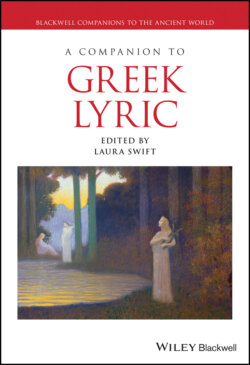Читать книгу A Companion to Greek Lyric - Группа авторов - Страница 65
Notes
Оглавление1 1 See, however, Lane Fox 2000: 39, who suggests that Theagenes is not the tyrant imagined in lines 39–52 and that Theognis can therefore be dated to the first half of the sixth century.
2 2 Kontoleon (1964: 44) identified two marble slabs, dating to ca. 510 BC, as part of the monument, whose original location is unknown. The first depicts a bull being attacked by a lion and the second a banqueting scene. An associated Ionic capital bears an inscription dated to the fourth century: “Archilochus of Paros, son of Telesicles, lies here; this monument was dedicated by Dokimos, son of Neokreon.” See also Schilardi 1996: 58.
3 3 Although Plato (Laws 629a–b), Lycurgus (Leoc. 106), and Philochorus (328 FGrH 215) all say that Tyrtaeus was Athenian by origin, it is generally accepted that he was a Spartan poet. See Lefkowitz 2012: 40.
4 4 Kontoleon 1964; Graham 1978; Jeffery 1990: 300–301, 307 no. 61; Parker 1997: 62–67, 76–79; Osborne 2009: 220–224.
5 5 Morris 1986; van Wees 1992; Raaflaub 1998.
6 6 Forsdyke 2005: 42; Gehrke 2009: 405; Hall 2014: 142–144; Stein-Hölkeskamp 2015: 143.
7 7 Plutarch, probably following the now lost Aristotelian Constitution of the Lacedaemonians, says that the veto clause was added later, “after the multitude twisted and violated proposals by subtraction and addition.” But this is probably an inference generated by a chronological difficulty: while Tyrtaeus seems to have linked the Rhetra to the joint rule of Polydorus and Theopompus in the early seventh century, Aristotle dated Lycurgus, who is supposed to have been the architect of the document, to the first Olympic Games of 776 BC. Ancient authors, however, offered a variety of dates for Lycurgus and there are good reasons to believe that the legend concerning his famed legislation and connection with Sparta postdates Tyrtaeus, in which case there is no obstacle to seeing the veto as an integral part of the original constitutional provisions: see Thommen 1996: 33–36.
8 8 Van Wees 1999 has argued that the oracle to which Tyrtaeus refers is unconnected with the Great Rhetra as presented in Plutarch. Nevertheless, even if there is a clear difference in emphasis between the two accounts, the central features (kings; elders; damos) and certain linguistic expressions are common to both: see Hall 2014: 207–211.
9 9 Wallace 2009: 417 may be right to point out that “[e]arly regimes should not be called “aristocracies” without configuring the power of popular assemblies…free speech, resistance to elite abuse, and pervasive mentalities of personal independence among the Greek populace;” such popular representation might explain the circumstances in which Solon was chosen as a mediator between the wealthy and the poor at Athens ([Arist.] Ath. Pol. 5.2. Nevertheless, Solon himself admits (fr. 5) that he did not increase the privileges of the dēmos.
10 10 Although Ath. Pol. 4.3 says that there was a council of 401, distinct from the Areopagus, under the legislation of Dracon in the archonship of Aristaichmos (621/0 BC).
11 11 See, however, Berent 1996, who argues that the polis was a “stateless society”—a position that is challenged in Hansen 2002.
12 12 Thomas and Conant 1999: 32–59; Morris 2000: 225–228; Mazarakis Ainian 2006.
13 13 On aristocratic culture, see Węcowski (Chapter 5) in this volume.
14 14 For critiques, see Hammer 2004; Kistler 2004; Irwin 2005: 58–62; Hall 2014: 200–203; van Wees and Fisher 2015: 25–27; Giangiulio 2015: 21–31.
15 15 This interpretation, detailed further in Hall 2014: 214–20, is influenced by Gallant 1982 and Rihll 1991. For alternative interpretations, see Murray 1993a: 189–94; Manville 1990: 124–56; Harris 1997; Foxhall 1997.
16 16 Forsdyke 2005: 53–55 compares the Solonian seisachtheia (“shaking-off of burdens”) to the palintokia, or return of interest paid on debts, that Plutarch (Mor. 295c–d) attests for sixth-century Megara.
17 17 The apologetic tone of Plutarch’s sources in Vit. Sol. 14–15 that Solon refused invitations to set himself up as tyrant surely implies a counternarrative.
18 18 Since Megara was famous for the export of woolen garments, these flocks, if the story is true, would have been an important source of elite wealth and power: Forsdyke 2005: 53. Figueira 1985: 144–145 notes that there is no river of any account in the Megarid and conjectures that the Aristotelian notice is loosely based on a sacrificial slaughter of victims for a festival named the Potamia.
19 19 Robinson 1997 collects the evidence for early experiments in popular government, though some caution needs to be exercised with regard to the interpretation of the sources: see Hansen 1999.
